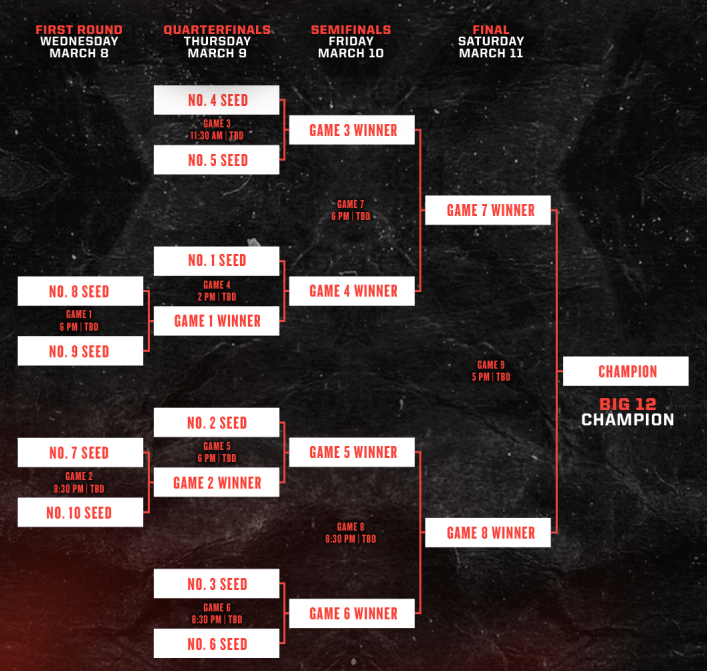Hoops
Seeding Scenarios: Oklahoma State Could Finish as High as Sixth, as Low as Eighth in Big 12
The difference between sixth and seventh is big in Big 12 seeding.

Entering the Big 12’s final slate of games, the Cowboys still have an opportunity to skip the first round at the Big 12 Tournament next week in Kansas City.
With a 7-10 league record, Oklahoma State sits seventh on the league table heading into the final game day, but the Cowboys are just a game back of Iowa State. Should OSU and the Cyclones tie, OSU would get the higher seed in Kansas City because the Cowboys swept ISU this season. OSU plays Texas Tech at 5 p.m. Saturday in Lubbock while Iowa State plays Baylor at 11 a.m. Saturday in Waco. Should OSU secure the 6 seed, the Cowboys would play the 3 seed (Baylor for now, but it’s tight at the top) in the quarterfinals.
OSU can’t finish any lower in the Big 12 than eighth. That would involve OSU losing to Tech this weekend and West Virginia beating Kansas State in Morgantown. That scenario puts OSU and West Virginia at 7-11, but the Mountaineers would get the higher seed because, after the teams split the regular season series, West Virginia would have a winner over the highest seed (being Kansas State). This scenario would see OSU rematching the Red Raiders in the first round of the conference tournament.
If OSU and West Virginia both lose this weekend, the Cowboys would secure the seventh seed and play the 10 seed (which would be Oklahoma in this scenario) in the first round.
It’s a lot to try to decipher, but here is all the info heading into Saturday:
Big 12 Standings
| Team | Conference Record | Overall Record |
| Kansas | 13-4 | 25-5 |
| Kansas State | 11-6 | 23-7 |
| Baylor | 11-6 | 22-8 |
| Texas | 11-6 | 22-8 |
| TCU | 9-8 | 20-10 |
| Iowa State | 8-9 | 17-12 |
| Oklahoma State | 7-10 | 16-14 |
| West Virginia | 6-11 | 17-13 |
| Texas Tech | 5-12 | 16-14 |
| Oklahoma | 4-13 | 14-16 |
Big 12 Bracket

Big 12 Tiebreakers
Ties Involving Two Teams
a. Results of head-to-head competition during the regular season. If teams remain tied, then:
- Each team’s record versus the team occupying the highest position in the final regular season standings, and then continuing down through the standings until one team gains an advantage. When arriving at another group of tied teams while comparing records, use each team’s record against the collective tied teams as a group (prior to that group’s own tiebreaking procedures), rather than the performance against individual tied teams. The lone exception to this guideline would be if there are only two tied teams in the group placement and one of the teams won both regular-season games. In this instance, the tie is deemed broken and comparison of the seed rather than the placement will be utilized.
- A comparison of the tied teams Conference-games only road record.
- A comparison of the tied teams Conference games only road record versus the team(s) occupying the highest position in the final Conference regular season standings, and then counting down through the standings until one team gains an advantage. When arriving at another group of tied teams while comparing records, use each team’s record against the collective tied teams as a group (prior to that group’s own tie breaking procedure), rather than the performance against individual tied teams. The lone exception to this guideline would be if there are only two tied teams in the group placement and one of the teams won both regular-season games. In this instance, the tie is deemed broken and comparison of the seed rather than the placement will be utilized.
- Draw. In the event tiebreaking procedures are unsuccessful and a draw is necessary in determining any portion of seeding, the following procedure will be used:
(1) The draw will be conducted in public or with media attendance.
(2) Institutions involved in the drawing have the right to have a local representative in attendance at the drawing;
(3) A single slip of paper for each institution (with name or logo) will be placed into a container and will be drawn in order of seeding from highest to lowest.
Ties involving more than two teams
a. Results from the collective head-to-head competition during the regular season among the tied teams in a mini round-robin format, ranking the tied teams by winning percentage from highest to lowest will be used to determine the seeds.
- If during this process two teams remain tied with the same winning percentage, the two-team tiebreaking system is used, starting with head-to-head results.
If during this process more than two teams remain tied with the same winning percentage, a second mini round-robin format is implemented, ranking the remaining tied teams by winning percentage from highest to lowest to determine seeds. If the teams remain tied, then the two-team tiebreaking system is used, starting with head-to-head results.
b. If more than two teams are still tied, each of the tied team’s record versus the team occupying the highest position in the final regular season standings, and then continuing down through the standings, eliminating tied teams with inferior records until one team gains an advantage. When arriving at another group of tied teams while comparing records, use each team’s record against the collective tied teams as a group (prior to that group’s own tiebreaking procedure), rather than the performance against individual tied teams. The lone exception to this guideline would be if there are only two tied teams in the group placement and one of the teams won both regular-season games. In this instance, the tie is deemed broken and comparison of the seed rather than the placement will be utilized.
c. If more than two teams are still tied, a comparison of the tied teams Conference games only road record.
d. If more than two teams are still tied, a comparison of the tied teams Conference games only road records versus the team(s) occupying the highest position in the final Conference regular season standings, and then continuing down through the standing until one team gains an advantage. If at any point the multiple-teams tie is reduced to two teams, the two-team tie breaking procedures above will be applied.

-

 Wrestling4 days ago
Wrestling4 days agoThe Top 5 Quotes from John Smith’s Retirement News Conference
-

 Wrestling2 days ago
Wrestling2 days agoOSU Wrestling: How John Smith Started a Tradition of Late-Night Workouts For Cowboys Seeking World Glory
-

 Wrestling4 days ago
Wrestling4 days agoOSU Wrestling: The Impact John Smith Had on His Final Boss, Chad Weiberg
-

 Hoops4 days ago
Hoops4 days agoJustin McBride Enters Transfer Portal






